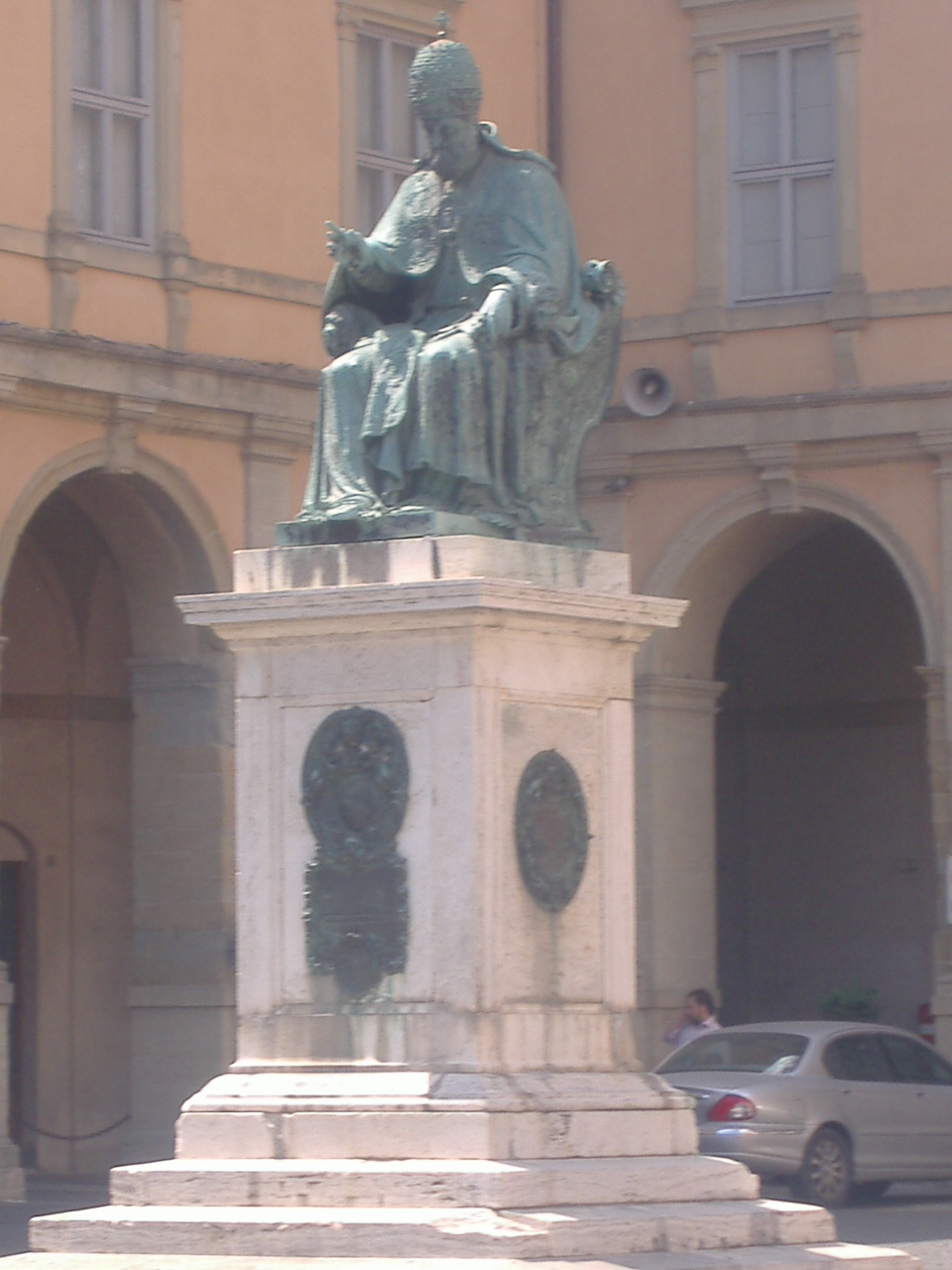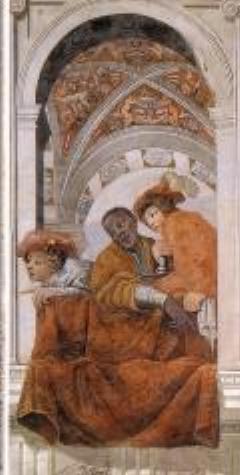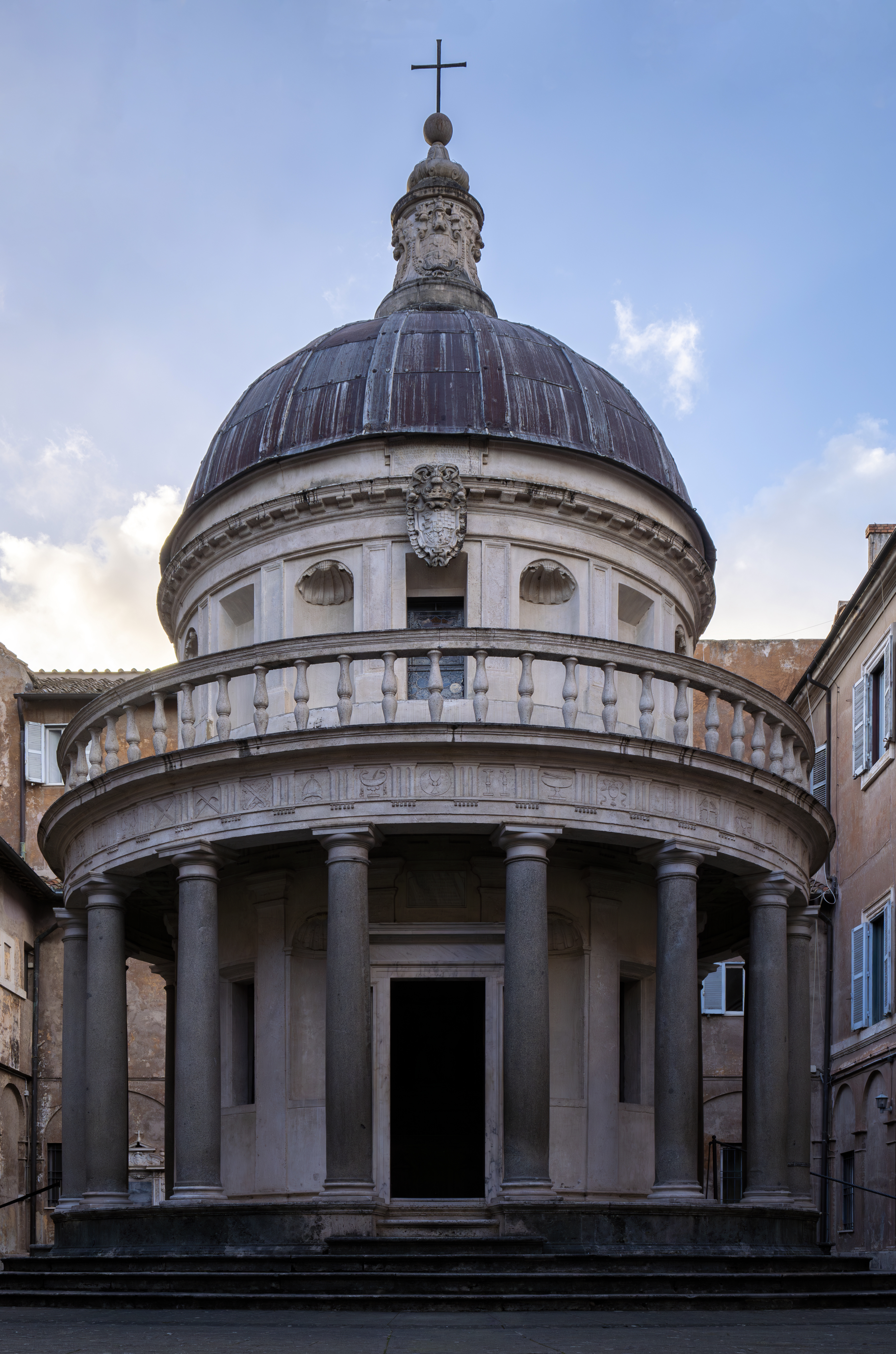|
Basilica Della Santa Casa
The Basilica della Santa Casa () is a Marian shrine in Loreto, Marche, Loreto, in Marche, the Marches, Italy. The basilica is known for enshrining the house in which the Blessed Virgin Mary is believed by some Catholics to have lived. Pious legends claim the same house was flown over by angelic beings from Nazareth to Tersatto (Trsat in Croatia), then to Recanati, before arriving at the current site. The basilica is also known for enshrining the Madonna and Child image of "Our Lady of Loreto". Pope Benedict XV designated her under this title as patroness of air passengers and auspicious travel on 24 March 1920. Pope Pius XI granted a Canonical Coronation to the venerated image made of Cedar of Lebanon wood on 5 September 1922, replacing the original Marian image consumed in fire on 23 February 1921. The church The basilica containing the is a Gothic architecture, Late Gothic structure built starting from 1468, and continued by Giuliano da Maiano, Giuliano da Sangallo ... [...More Info...] [...Related Items...] OR: [Wikipedia] [Google] [Baidu] |
Catholic Church
The Catholic Church (), also known as the Roman Catholic Church, is the List of Christian denominations by number of members, largest Christian church, with 1.27 to 1.41 billion baptized Catholics Catholic Church by country, worldwide as of 2025. It is among the world's oldest and largest international institutions and has played a prominent role in the history and development of Western civilization.Gerald O'Collins, O'Collins, p. v (preface). The church consists of 24 Catholic particular churches and liturgical rites#Churches, ''sui iuris'' (autonomous) churches, including the Latin Church and 23 Eastern Catholic Churches, which comprise almost 3,500 dioceses and Eparchy, eparchies List of Catholic dioceses (structured view), around the world, each overseen by one or more Bishops in the Catholic Church, bishops. The pope, who is the bishop of Rome, is the Papal supremacy, chief pastor of the church. The core beliefs of Catholicism are found in the Nicene Creed. The ... [...More Info...] [...Related Items...] OR: [Wikipedia] [Google] [Baidu] |
Cedar Of Lebanon
''Cedrus libani'', commonly known as cedar of Lebanon, Lebanon cedar, or Lebanese cedar (), is a species of large evergreen conifer in the genus ''Cedrus'', which belongs to the pine family and is native to the mountains of the Eastern Mediterranean basin. Known for its longevity, height, and durable wood, it has held profound significance for millennia. The tree features in ancient Mesopotamian and Israelite literature, notably in the in the Hebrew Bible, according which the tree was used in the construction of the Jerusalem Temple by Solomon, who received the trees from Hiram of Tyre. Today, it is the national emblem of Lebanon and is widely used as an ornamental tree in parks and gardens. Description ''Cedrus libani'' can reach in height, with a massive monopodial columnar trunk up to in diameter.Farjon 2010, p. 258 The trunks of old, open-grown trees often fork into several large, erect branches.Masri 1995 The rough and scaly bark is dark grey to blackish brown, and ... [...More Info...] [...Related Items...] OR: [Wikipedia] [Google] [Baidu] |
Campanile
A bell tower is a tower that contains one or more bells, or that is designed to hold bells even if it has none. Such a tower commonly serves as part of a Christian church, and will contain church bells, but there are also many secular bell towers, often part of a municipal building, an educational establishment, or a tower built specifically to house a carillon. Church bell towers often incorporate clocks, and secular towers usually do, as a public service. The term campanile (, also , ), from the Italian ''campanile'', which in turn derives from ''campana'', meaning "bell", is synonymous with ''bell tower''; though in English usage campanile tends to be used to refer to a free standing bell tower. A bell tower may also in some traditions be called a belfry, though this term may also refer specifically to the substructure that houses the bells and the ringers rather than the complete tower. The tallest free-standing bell tower in the world, high, is the Mortegliano Bell To ... [...More Info...] [...Related Items...] OR: [Wikipedia] [Google] [Baidu] |
Baptismal Font
A baptismal font is an Church architecture, ecclesiastical architectural element, which serves as a receptacle for baptismal water used for baptism, as a part of Christian initiation for both rites of Infant baptism, infant and Believer's baptism, adult baptism. Aspersion and affusion fonts The earliest western fonts are found in the Catacombs of Rome. The fonts of many western Christian denominations that practice infant baptism are designed for baptisms using a non-immersive method, such as aspersion (sprinkling) or affusion (pouring). The simplest of these fonts has a pedestal with a holder for a basin of water. The materials vary greatly, consisting of carved and sculpted stone (including marble), wood, or metal in different shapes. Many fonts are in Octagon, octagonal shape, as a reminder of the new creation and as a connection to the Old Testament practice of circumcision, which traditionally occurs on the eighth day. Some fonts are three-sided as a reminder of the Holy T ... [...More Info...] [...Related Items...] OR: [Wikipedia] [Google] [Baidu] |
Tiburzio Vergelli
Tiburzio Vergelli (1551-1609) was an Italian sculptor and founder. Born in Camerino, Vergelli was a highly skilled metal smelter. He trained in the workshop of Antonio Calcagni and Girolamo Lombardo in Recanati. His first work is the statue of Pope Sixtus V, given to his hometown Camerino. In the aftermath of the election of a new Pope, this statue was done around the same time as Calcagni was working on a similar statue for Loreto, Marche (1585–1587) and follows the same compositional scheme. This generated a split between the two, who subsequently contributed separately to the main door of the Basilica della Santa Casa The Basilica della Santa Casa () is a Marian shrine in Loreto, Marche, Loreto, in Marche, the Marches, Italy. The basilica is known for enshrining the house in which the Blessed Virgin Mary is believed by some Catholics to have lived. Pious legen ...; Calcagni was entrusted to the door of the south side, and the north side was given to Vergelli. Vergelli w ... [...More Info...] [...Related Items...] OR: [Wikipedia] [Google] [Baidu] |
Pope Paul V
Pope Paul V (; ) (17 September 1552 – 28 January 1621), born Camillo Borghese, was head of the Catholic Church and ruler of the Papal States from 16 May 1605 to his death, in January 1621. In 1611, he honored Galileo Galilei as a member of the papal Accademia dei Lincei and supported his discoveries. In 1616, Pope Paul V instructed Cardinal Robert Bellarmine to inform Galileo that the Copernican theory could not be taught as fact, but Bellarmine's certificate allowed Galileo to continue his studies in search for evidence and use the geocentric model as a theoretical device. That same year Paul V assured Galileo that he was safe from persecution so long as he, the Pope, should live. Bellarmine's certificate was used by Galileo for his defense at the trial of 1633. Trained in jurisprudence, Borghese was made Cardinal-Priest of Sant'Eusebio and the Cardinal Vicar of Rome by Pope Clement VIII. He was elected as Pope in 1605, following the death of Pope Leo XI. Pope ... [...More Info...] [...Related Items...] OR: [Wikipedia] [Google] [Baidu] |
Girolamo Lombardo
Girolamo Lombardo, also Girolamo Lombardi (1506–1590), was an Italian sculptor. Life Lombardo was born in Ferrara, the son of the architect and sculptor Antonio Lombardo (sculptor), Antonio Lombardo, and also was the brother of Lodovico Lombardo, Lodovico and Aurelio Lombardo, Aurelio, also sculptors. He studied and began in his father's workshop in Ferrara, then subsequently traveled to Venice to continue training with Jacopo Sansovino, with which, between 1532 and 1540, he worked in the Biblioteca Marciana in the Loggia of the bell tower of Saint Mark's in Venice. Lombardo is documented in Loreto, Marche since 1543, where for some years he was active with his brother Aurelio and where they were in 1550 also reached the third brother, Lodovico. Around 1552 he moved with his brothers and opened their own foundry and workshop in Recanati, passing the Venetian mature technique to all operators of the workshop. The school sculptural continued in subsequent generations with Tibur ... [...More Info...] [...Related Items...] OR: [Wikipedia] [Google] [Baidu] |
Parvis
A parvis or parvise is the open space in front of and around a cathedral or Church (building) , church, especially when surrounded by either colonnades or porticoes, as at St. Peter's Basilica in Rome. It is thus a church-specific type of forecourt, front yard or apron. Etymology The term derives via Old French from the Latin ''paradisus'' meaning "paradise". This in turn came via Ancient Greek from the Indo-European languages, Indo-European Aryan languages of History of Iran, ancient Iran, where it meant a walled enclosure or garden precinct with heavenly flowers planted by the Clercs (Clerics). Parvis of St Paul's Cathedral In London in the England in the Middle Ages, Middle Ages the Serjeant-at-law, Serjeants-at-law practised at the parvis of St Paul's Cathedral, where clients could seek their counsel. In the 14th century Geoffrey Chaucer referred to ''"A sergeant of the laws ware and wise/ That often hadde yben at the parMiddle English orthography, uis..."''. Later, eccle ... [...More Info...] [...Related Items...] OR: [Wikipedia] [Google] [Baidu] |
Pope Sixtus V
Pope Sixtus V (; 13 December 1521 – 27 August 1590), born Felice Piergentile, was head of the Catholic Church and ruler of the Papal States from 24 April 1585 to his death, in August 1590. As a youth, he joined the Franciscan order, where he displayed talents as a scholar and preacher, and enjoyed the patronage of Pius V, who made him a Cardinal (Catholic Church), cardinal. As a cardinal, he was known as Cardinal Montalto. As Pope, he energetically rooted out corruption and lawlessness across Rome, and launched a far-sighted rebuilding programme that continues to provoke controversy, as it involved the destruction of antiquities. The cost of these works was met by heavy taxation which caused much suffering. His foreign policy was regarded as over-ambitious; he excommunicated King Henry IV of France and renewed the excommunication of Queen Elizabeth I of England. He is recognized as a significant figure of the Counter-Reformation. He is the most recent pope to date to take on ... [...More Info...] [...Related Items...] OR: [Wikipedia] [Google] [Baidu] |
Façade
A façade or facade (; ) is generally the front part or exterior of a building. It is a loanword from the French language, French (), which means "frontage" or "face". In architecture, the façade of a building is often the most important aspect from a design standpoint, as it sets the tone for the rest of the building. From the engineering perspective, the façade is also of great importance due to its impact on Efficient energy use, energy efficiency. For historical façades, many local zoning regulations or other laws greatly restrict or even forbid their alteration. Etymology The word is a loanword from the French , which in turn comes from the Italian language, Italian , from meaning 'face', ultimately from post-classical Latin . The earliest usage recorded by the ''Oxford English Dictionary'' is 1656. Façades added to earlier buildings It was quite common in the Georgian architecture, Georgian period for existing houses in English towns to be given a fashionable new f ... [...More Info...] [...Related Items...] OR: [Wikipedia] [Google] [Baidu] |
Donato Bramante
Donato Bramante (1444 – 11 April 1514), born as Donato di Pascuccio d'Antonio and also known as Bramante Lazzari, was an Italian architect and painter. He introduced Renaissance architecture to Milan and the High Renaissance style to Rome, where his plan for St. Peter's Basilica formed the basis of the design executed by Michelangelo. His Tempietto (San Pietro in Montorio) marked the beginning of the High Renaissance in Rome (1502) when Pope Julius II appointed him to build a sanctuary over the spot where Peter was martyred. Life Urbino Bramante was born under the name Donato d'Augnolo, Donato di Pascuccio d'Antonio, or Donato Pascuccio d'Antonio in Fermignano near Urbino. Here, in 1467, Luciano Laurana was adding to the Palazzo Ducale an arcaded courtyard and other Renaissance features to Federico da Montefeltro's ducal palace. Bramante's architecture has eclipsed his painting skills: he knew the painters Melozzo da Forlì and Piero della Francesca well, who were ... [...More Info...] [...Related Items...] OR: [Wikipedia] [Google] [Baidu] |
Giuliano Da Sangallo
Giuliano da Sangallo (c. 1445 – 1516) was an Italian sculptor, architect and military engineer active during the Italian Renaissance. He is known primarily for being the favored architect of Lorenzo de' Medici, his patron. In this role, Giuliano designed a villa for Lorenzo as well as a monastery for Augustinians and a church where a miracle was said to have taken place. Additionally, Giuliano was commissioned to build multiple structures for Pope Julius II and Pope Leo X. Leon Battista Alberti and Filippo Brunelleschi heavily influenced Sangallo and in turn, he influenced other important Renaissance figures such as Raphael, Leonardo da Vinci, his brother Antonio da Sangallo the Elder, and his sons, Antonio da Sangallo the Younger and Francesco da Sangallo. Early life Giuliano da Sangallo (né Giuliano Giamberti) was born c. 1445 in Florence. His father, Francesco Giamberti, was a woodworker and an architect who worked closely with Cosimo de' Medici. This proved to be he ... [...More Info...] [...Related Items...] OR: [Wikipedia] [Google] [Baidu] |










